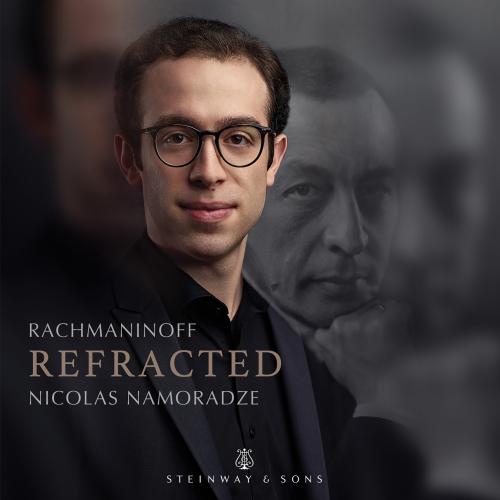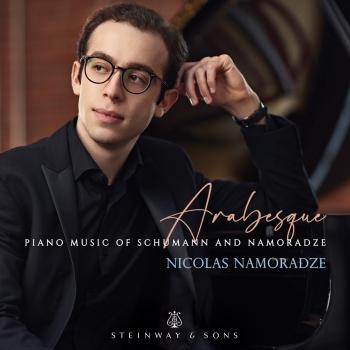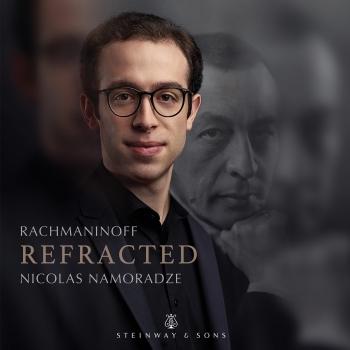
Rachmaninoff, Refracted Nicolas Namoradze
Album info
Album-Release:
2023
HRA-Release:
01.11.2023
Label: Steinway and Sons
Genre: Classical
Subgenre: Instrumental
Artist: Nicolas Namoradze
Composer: Sergei Rachmaninoff (1873-1934)
Album including Album cover Booklet (PDF)
This Album is available for streaming only.
Thank you for your interest in this album. It is available for streaming only.
Get a streaming subscription to listen to this album.
- Johann Sebastian Bach (1685 - 1750): Violin Partita No. 3 in E Major, BWV 1006:
- 1 Bach: Violin Partita No. 3 in E Major, BWV 1006: III. Gavotte en rondeau (Arr. for Piano by Sergei Rachmaninoff) 03:11
- Sergei Rachmaninoff (1873 - 1943): Symphony No. 2 in E Minor, Op. 27:
- 2 Rachmaninoff: Symphony No. 2 in E Minor, Op. 27: III. Adagio (Arr. for Piano by Nicolas Namoradze) 13:25
- 14 Romances, Op. 34:
- 3 Rachmaninoff: 14 Romances, Op. 34: No. 14, Vocalise (Arr. for Piano by Zoltán Kocsis) 07:52
- Piano Sonata No. 1 in D Minor, Op. 28:
- 4 Rachmaninoff: Piano Sonata No. 1 in D Minor, Op. 28: I. Allegro moderato 13:39
- 5 Rachmaninoff: Piano Sonata No. 1 in D Minor, Op. 28: II. Lento 08:11
- 6 Rachmaninoff: Piano Sonata No. 1 in D Minor, Op. 28: III. Allegro molto 16:12
- Nicolas Namoradze (b. 1992): Memories of Rachmaninoff’s Georgian Song
- 7 Namoradze: Memories of Rachmaninoff’s Georgian Song 05:03
Info for Rachmaninoff, Refracted
Pianist and composer Nicolas Namoradze’s new album, Rachmaninoff Refracted, explores the oeuvre of Sergei Rachmaninoff on the occasion of his 150th anniversary year. Namoradze approaches his work from several angles: as a pianist, composer, transcriber, and one whose music is arranged.
In his liner notes for the album Namoradze writes: Rachmaninoff’s monumental Piano Sonata No. 1 constitutes the program’s center of gravity, and is complimented by one of his most celebrated transcriptions, as well as a set of recent arrangements and reflections on his work—a testament not only to the continued centrality of his musical output in the core repertory but also the freshness of his oeuvre and the new forms and guises in which it appears today.
Opening the album is Rachmaninoff’s iconic arrangement of the Gavotte from the Third Partita for Solo Violin by Johann Sebastian Bach (1685-1750). The Gavotte is one of three movements that Rachmaninoff transcribed in 1933, along with the Preludio and Gigue. In the sprightly, elegant Gavotte, rather than simply realizing Bach’s string writing on the keyboard Rachmaninoff adds several polyphonic layers, yielding not only considerably denser textures but also a plethora of new harmonic motions. This complexity reflects his fascination with the counterpoint of Bach—a significant influence on Rachmaninoff’s piano writing.
The next work on the program is my arrangement for solo piano of the Adagio from Rachmaninoff’s Symphony No. 2 in E minor, Op. 27. Since its highly successful premiere in 1908 the symphony remains among Rachmaninoff’s most celebrated musical statements, and the third movement, Adagio, is emblematic of many features that define his compositional language, including enchantingly expansive melodies, a rich harmonic palette, searing climaxes, and lush, full textures. While adhering strictly to the thematic and harmonic material of the original, this arrangement is less a strict transcription and more a reimagining of the movement for the piano, taking a generally liberal approach with reworking the textures in order to create a pianistically idiomatic piece. The piano writing is informed both by Rachmaninoff’s compositional style as well as my own approach to keyboard texture.
Another arrangement of Rachmaninoff’s work follows: the Vocalise, Op. 34 No. 14, transcribed for solo piano by Zoltán Kocsis (1952-2016). Among Rachmaninoff’s most widely performed songs, the Vocalise is something of an anomaly given its lack of text (as suggested by its title), with the singer vocalizing a sorrowful, haunting vocal line. This feature has also made the song especially amenable to arrangements, with multiple versions in existence for a variety of instrumentations. Kocsis’s solo piano transcription remains generally faithful to the original texture until the final reprise of the opening material, which is adorned by crystalline, gently fluttering arabesques in the upper registers of the keyboard.
The Vocalise makes way for the centerpiece of the disc, Rachmaninoff’s Piano Sonata No. 1 in D minor, Op. 28. Completed in 1907, it is his most symphonic creation for the piano, and closest in spirit to another work he was writing during this period—the Symphony No. 2. Despite several revisions and attempts on the part of the composer to condense the work, the sonata remains colossal in scale and breadth—reflecting his original programmatic conception of the piece, based on the epic of Faust. According to accounts of his contemporaries, Rachmaninoff had intended the three movements to depict Faust, Gretchen and Mephistopheles in turn, thus taking after Liszt’s Faust Symphony and the Sonata in B minor. The brooding opening of the first movement makes way for a variety of thematic material at times agitated and anguished, at times resolute and valiant, alternating in a heroic struggle. The lyrical second movement, with its soaring melodies and beguilingly rich textures, provides some respite before the diabolical finale: a macabre tempest suffused with strains of the Dies Irae chant which, despite a number of attempts to emerge from the depths with references to the previous movements, ends cataclysmically.
I wrote Memories of Rachmaninoff’s Georgian Song, the final work on the album, for the sesquicentennial celebrations. It is based on an early song by Rachmaninoff, Oh, do not sing for me, Op. 4 No. 4, set to a poem by Pushkin and known as the “Georgian Song.” The song’s expressively winding and melismatic opening, highly reminiscent of Georgian folk music yet an original creation of Rachmaninoff’s, introduces the following verse:
Do not sing for me, my beauty,
Your sad Georgian songs of yore;
For they wake deep from my memory
Another life and a distant shore.
Memories of Rachmaninoff’s Georgian Song is neither an arrangement nor a paraphrase, but rather the musical equivalent of a faint, dreamlike recollection—an allusion to the topic of the original song itself. The work opens with a sparse figuration where strains of the song’s melody are occasionally suggested, as if from far away. A gradual thickening of the texture leads to a more recognizable utterance of Rachmaninoff’s thematic material before the work retreats back into the realm of distant memory. (Nicolas Namoradze)
Nicolas Namoradze, piano
Nicolas Namoradze
Pianist and composer Nicolas Namoradze, whose performances have been hailed by critics as “sparkling … sensitive and coloristic” (New York Times) and “simply gorgeous” (Wall Street Journal), came to international attention in 2018 upon winning the triennial Honens International Piano Competition in Calgary, Canada—the largest piano prize in the world. The Calgary Herald called him “unparalleled” and “a pianist’s pianist” stating: “Namoradze is not the conventional competition pianist, but his individuality was evident from the outset. While he certainly has the virtuosity to spare, he gained the top spot through his remarkable clarity of execution, refinement and variety of tone, and his uncanny ability to make even the most ordinary passagework sound meaningful and distinctive … The refinement of his playing was of international standard, and everywhere his interpretative skills commanded attention and admiration.”
As 2018 Honens Prize Laureate, Namoradze’s upcoming activities include debut recitals at Carnegie Hall in New York, Wigmore Hall in London, and Konzerthaus Berlin, recordings on the Honens, Steinway, and Hyperion labels, performances with orchestras such as the London Philharmonic, and residencies at leading festivals and music centers around the world such as the Banff Centre for Arts and Creativity.
Highlights of the past season include performances at New York City’s Chelsea Music Festival as a featured composer and pianist, commissions for ensembles such as the Barkada and Verona Quartets, and a series of recitals with violinist Rolf Schulte. Namoradze also composed and produced the soundtracks for Walking Painting, a film by Fabienne Verdier, and Nuit d’opéra à Aix, a short film made in association with the Festival d’Aix-en-Provence.
Enthusiastic of innovative programs and technologies that expand the reach of classical music around the world, Namoradze has been closely associated with Juilliard Global Ventures: he has represented Juilliard students in the Julliard-Nord Anglia Performing Arts Program, features in the most-watched episode of Juilliard Open Studios with his teacher, Emanuel Ax, and appears as a guest educator on the history of the piano for Juilliard edX courses. Nicolas Namoradze’s interest in contemporary music and lesser-known works of the piano repertoire has led him to present original and exciting programs including Godowsky’s infamous Studies on Chopin Études, sets of Ligeti Études, rarities such as Dvořák’s Piano Concerto, and many works by his contemporaries.
After completing his undergraduate studies in Budapest, Vienna, and Florence, Nicolas moved to New York for his master’s at Juilliard. He now pursues his Doctorate at the CUNY Graduate Center holding the Graduate Center Fellowship. His teachers have included Emanuel Ax, Yoheved Kaplinsky, Zoltán Kocsis, Matti Raekallio, and Elisso Virsaladze in piano, and John Corigliano in composition. Namoradze serves on the faculty of Queens College. He is also on the Executive Advisory Council of The Drozdoff Society as Special Project Leader, developing curricula for courses in piano and composition for its partnerships with El Sistema-based music schools.
Booklet for Rachmaninoff, Refracted











